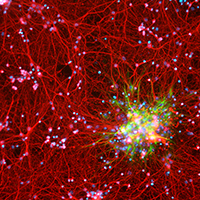Quantitative, structural and molecular changes in neuroglia of aging mammals: A review

Accepted: 27 May 2021
HTML: 11
All claims expressed in this article are solely those of the authors and do not necessarily represent those of their affiliated organizations, or those of the publisher, the editors and the reviewers. Any product that may be evaluated in this article or claim that may be made by its manufacturer is not guaranteed or endorsed by the publisher.
Authors
The neuroglia of the central and peripheral nervous systems undergo numerous changes during normal aging. Astrocytes become hypertrophic and accumulate intermediate filaments. Oligodendrocytes and Schwann cells undergo alterations that are often accompanied by degenerative changes to the myelin sheath. In microglia, proliferation in response to injury, motility of cell processes, ability to migrate to sites of neural injury, and phagocytic and autophagic capabilities are reduced. In sensory ganglia, the number and extent of gaps between perineuronal satellite cells – that leave the surfaces of sensory ganglion neurons directly exposed to basal lamina– increase significantly. The molecular profiles of neuroglia also change in old age, which, in view of the interactions between neurons and neuroglia, have negative consequences for important physiological processes in the nervous system. Since neuroglia actively participate in numerous nervous system processes, it is likely that not only neurons but also neuroglia will prove to be useful targets for interventions to prevent, reverse or slow the behavioral changes and cognitive decline that often accompany senescence.
How to Cite
PAGEPress has chosen to apply the Creative Commons Attribution NonCommercial 4.0 International License (CC BY-NC 4.0) to all manuscripts to be published.
Similar Articles
- A Balestrazzi, G Bernacchia, L Pitto, G Luccarini, D Carbonera, Spatial expression of DNA topoisomerase I genes during cell proliferation in Daucus carota , European Journal of Histochemistry: Vol. 45 No. 1 (2001)
- M Iwasa, Y Imamura, S Noriki, Y Nishi, H Kato, M Fukuda, Immunohistochemical detection of early-stage carcinogenesis of oral leukoplakia by increased DNA-instability and various malignancy markers , European Journal of Histochemistry: Vol. 45 No. 4 (2001)
- D. Curzi, S. Salucci, M. Marini, F. Esposito, L. Agnello, A. Veicsteinas, S. Burattini, E. Falcieri, How physical exercise changes rat myotendinous junctions: an ultrastructural study , European Journal of Histochemistry: Vol. 56 No. 2 (2012)
- M.G. Manfredi Romanini, Nuclear histochemistry: Its history in fifty volumes , European Journal of Histochemistry: Vol. 50 No. 1 (2006)
- G. Orsini, A. Majorana, A. Mazzoni, A. Putignano, M. Falconi, A. Polimeni, L. Breschi, Immunocytochemical detection of dentin matrix proteins in primary teeth from patients with dentinogenesis imperfecta associated with osteogenesis imperfecta , European Journal of Histochemistry: Vol. 58 No. 4 (2014)
- AI Scovassi, A Torriglia, Activation of DNA-degrading enzymes during apoptosis , European Journal of Histochemistry: Vol. 47 No. 3 (2003)
- MG Rambotti, G Altissimi, A Spreca, Enzyme-ultracytochemical study of adenylate and guanylate cyclases in normal and pathologic human nasal mucosa , European Journal of Histochemistry: Vol. 48 No. 3 (2004)
- Wenqian Xie, Hong Liu, Qian Liu, Qiong Gao, Fuli Gao, Yingying Han, Zhengrong Yuan, Haolin Zhang, Qiang Weng, Seasonal expressions of prolactin, prolactin receptor and STAT5 in the scented glands of the male muskrats (Ondatra zibethicus) , European Journal of Histochemistry: Vol. 63 No. 1 (2019)
- Claudio Pigoli, Lucia Rita Gibelli, Mario Caniatti, Luca Moretti, Giuseppe Sironi, Chiara Giudice, Bleaching melanin in formalin-fixed and paraffin-embedded melanoma specimens using visible light: a pilot study , European Journal of Histochemistry: Vol. 63 No. 4 (2019)
- T Yasui, A Tsukise, T Nara, Y Kuwahara, W Meyer, Morphological, histochemical and immunohistochemical characterization of secretory production of the ciliary glands in the porcine eyelid , European Journal of Histochemistry: Vol. 50 No. 2 (2006)
<< < 75 76 77 78 79 80 81 82 83 84 > >>
You may also start an advanced similarity search for this article.

 https://doi.org/10.4081/ejh.2021.3249
https://doi.org/10.4081/ejh.2021.3249










